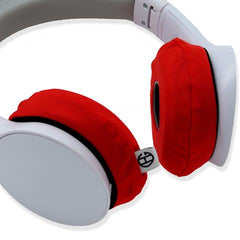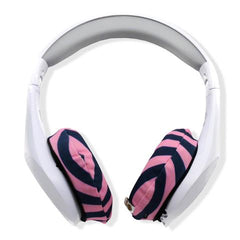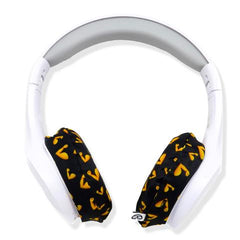What Are the Different Types of Headphone?
People tend to use the term ‘headphone’ interchangeably.
It covers the broad category of something Wikipedia describes as ‘a pair of small loudspeaker drivers worn on or around the head over a user's ears’. Some people use the term headphones when referring to in-earphones or earbuds, too, so whilst the above definition is technically correct, it doesn’t go quite far enough.
5 Types of Headphone
-
Over-ear headphones
-
On-ear headphones
-
Bone-conduction headphones
-
In-earphones
-
Earbuds
With added technology, the division between these 5-types of headphone can be expanded further but at a basic level, these are the main differences.
Over-Ear Headphones
Over-ear headphones are also known as BIG headphones. You’ll also hear them referred to as circumaural as the earcups cover the ears entirely.
Bose QuietComfort 35 II is one example of an over-ear headphone.
Over-ear headphones are often the most comfortable to wear because they have a thicker cushion over the earpad. They don’t have the same‘clamping effect’ that can sometimes reduce the comfort of on-ear headphones. Over-ears are heavier, however, so it’s important to find a model with a thick headband to distribute the weight equally across the top of your head.
Audiophiles swear by the sound quality of a good pair of over-ear headphones. This is partly because big headphones have space for bigger drivers giving them clarity of sound that can’t always be replicated in smaller headphones.
Circumaural headphones are heavier to wear and heavier to carry, so they’re not always convenient to take on trips or to put on during exercise. The thicker earpads can make them hot to use for extended periods, too.
On-Ear Headphones
These are also called supra-aural headphones.
They’re smaller than over-ears and sit directly against the ear rather than covering it entirely.
Beats Solo3 Wireless is an on-ear headphone.
They’re more portable than over-ears and are lighter to wear so they’re often a better option for people on the move. Pair them with sweat-proof headphone covers, and you can even wear them to exercise in.
On-ears have a larger driver than in-earphones so you can usually expect a better standard of sound quality. Although, this isn’t always the case.
Because the cushions and earcups are small, they won’t make your ears feel as hot as over-ears can. Although, the downside to this is that passive noise-cancellation won’t be as good.
Some on-ears do have a clamping effect. Clamping keeps the headphone on our head and stops it from sliding off. Useful, yes, but also quite uncomfortable especially if you’re wearing them for extended periods.
Bone Conduction Headphones
We hear sound in two ways: through air conduction or bone conduction. Air conduction is how we hear most of the time and it’s how most headphones transmit soundwaves. Bone conduction is when soundwaves travel through our bones and skull. The technology is older than you’d think. It’s been used by the military for decades. Audiologists also use it to develop hearing aids.
It doesn’t matter whether you hear the sound through the air or through bone because it all ends up in the same place - the cochlear. It’s just that bone conduction bypasses the eardrum entirely. One of the biggest advantages of wearing a bone-conducting headphone is that it doesn’t block ambient noise. It’s useful for soldiers in combat situations as it helps them maintain situational awareness whilst still being able to communicate with other people. Cyclists and road-runners often wear bone-conducting headphones so that they can be aware of traffic and any potential dangers around them. One of the bigger disadvantages, however, is that the sound quality tends to be poorer than other types of headphone.
In-Earphones
In-earphones are one of the most common types of headphones. They’re portable and relatively inexpensive. They’re a favourite with anyone who exercises regularly, too. These are small speakers which press directly into the ear canal.
BeatsX would be an example of earphones.
The sound quality can vary and so does price. As in-earphones are so small the drivers delivering sound quality and clarity are small, too. In-earphones are popular but they’re not always comfortable to wear. Most manufacturers will supply different rubber tip sizes for new earphones but it’s hard to accommodate everyone. Ear canals vary in shape and size person-to-person. What fits one person won’t fit the next 5. This can be especially frustrating for those wearing earphones during a workout although, in-earphones do tend to fare better for people who sweat heavily during exercise and those who prefer not to wear big headphones.
Earbuds
Earbuds are earphones that don’t go directly into the ear canal. The speaker sits just inside the earlobe.
An example of an earbud would be Apple’s Airpods.
Earbuds are easy to carry around and take up almost no extra space inside bags or pockets. There’s usually a greater degree of sound leakage and they can make for poorer noise isolation. Although, that’s not necessarily indicative of all earbuds. Apple Airpods, for example, has been well received amongst wearers.
Additional Headphone Technology
The line dividing the different types of headphone doesn’t just stop with the 5 listed above. There are a number of additional technological add-ons that make choosing between types of headphone more personal than simply based on sound quality, appearance and price alone.
Noise-Cancelling Technology
Some headphones offer active noise-cancellation. Microphones inside the headphone detect incoming soundwaves and then send out intercepting waves to disrupt and interrupt it. This helps users enjoy audio without being disturbed by outside noise as well as reducing the need for wearers to turn up the volume and risk damaging their hearing.
Sweat-Proof
Some headphones and earphones are designed with exercising in mind. For earphones, the cushion or ear tip will be made from a material that wicks moisture away keeping the headphones smelling fresh and protecting the internal drivers from corrosive liquid. You can make almost any over-ear or on-ear headphone sweatproof by adding moisture-proof headphone covers to the cushions.
Open and Closed-Back
Closed-back headphones are sealed at the back.
They’re much better at noise-isolation and the sound is often clearer although it won’t be as authentic as an open back headphone. Closed-back will stop your disturbing other people, too, if you’re playing your music loudly in public places.
Open-back headphones are open at the back.
This allows more ambient noise through and makes them safer if you’re wearing them out and about on the street. They have what’s known as a ‘wider sound-stage’ which mean you hear a wider range of sounds (including noises in the environment around you). Some people prefer to wear these as they create a more authentic experience.
Wireless and Wired
This is pretty self-explanatory. Wired headphones have a cable that connects them to a device whilst wireless uses a Bluetooth connection to transmit sound to the headphone without the need for a cord.
Which Type of Headphone is Best?
There’s no correct answer to this question.
The answer depends on what you want to use the headphone for and what your budget is.
An audiophile might choose an open-back wired headphone to listen to albums at home. An athlete might pick sweat-resistant wireless earbuds. Weightlifters might pair a closed-back headphone with Earhugz sweat-proof covers. If you travel on public transport or long-haul flights regularly, then something with active noise-cancelling technology could be ideal.
The best type of headphone for you may be the one that fits your budget. If you only need to wear them occasionally during a quick run, then a cheap pair of earphones might be enough for you.
We don’t do spam BUT we do discounts, promotions and updates straight to your inbox.





